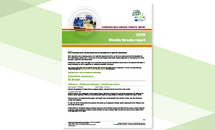Communicable disease threats report, 26 January - 1 February 2014, week 5
The ECDC communicable disease threats report is a weekly bulletin intended for epidemiologists and health professionals in the area of communicable disease prevention and control. Summarising information gathered by ECDC through its epidemic intelligence activities regarding communicable disease threats of concern to the European Union, it also provides updates on the global situation and changes in the epidemiology of communicable diseases with potential to affect Europe, including diseases that are the focus of eradication efforts.
Executive Summary
The ECDC Communicable Disease Threats Report (CDTR) is a weekly bulletin intended for epidemiologists and health professionals in the area of communicable disease prevention and control. This issue covers the period of 26 January to 1 February 2014 and focuses on the following:
Influenza season in Europe
During week 4 of 2014, influenza activity continued to increase in almost all EU/EEA countries, with differing proportions of A(H1N1)pdm09 and A(H3) between countries.
The season of active influenza transmission has started in EU/EEA countries as of week 2 of 2014.
Middle East respiratory syndrome - coronavirus (MERS CoV)
Since the previous CDTR, one new fatal case has been reported from Jordan. There have been also two new deaths in previously reported cases: one from the United Arab Emirates and one from Saudi Arabia.
Since April 2012, 180 laboratory-confirmed cases, including 79 deaths, of acute respiratory disease caused by Middle East respiratory syndrome coronavirus (MERS-CoV), have been reported by national health authorities. To date, all cases have either occurred in the Middle East, have had direct links to a primary case infected in the Middle East, or have returned from the Middle East. Human-to-human transmission to close contacts and in hospital settings has occurred, but there is no evidence of sustained transmission among humans.
Poliomyelitis - monitoring in outbreaks
In Syria, seven new cases were reported this week, all with onset of paralysis in November and December 2013, bringing the number of WPV1 cases to 23.
In 2013, 399 cases of poliomyelitis were notified to WHO worldwide, all due to WPV1. Eight countries have recorded cases in 2013: Somalia, Nigeria, Pakistan, Kenya, Afghanistan, Ethiopia, Syria and Cameroon. In 2014, six cases have been recorded so far, from Pakistan (5) and Afghanistan (1).
Chikungunya outbreak in the Caribbean
During the past week, 247 new cases of chikungunya have been reported in the Caribbean. Epidemiological data indicate that the outbreak, that started in Saint Martin (FR), is expanding. An increasing number of cases have been observed from most of the affected areas. The vector is endemic in the regions, where it also transmits dengue virus. Vigilance is recommended for the occurrence of imported cases of chikungunya in tourists returning to the EU from the Caribbean, including awareness among clinicians, travel clinics and blood safety authorities.
Zika virus infection outbreak in French Polynesia
During the past week, 15 additional confirmed cases of ZIKV infection were reported in French Polynesia. Japan reported two ZIKV cases in returning travellers from Bora Bora in the latest issue of Eurosurveillance.
In New Caledonia during last week, four new autochthonous cases of ZIKV were reported.
Since early October 2013, and as of 24 January 2014, 7 708 suspected cases of ZIKV infection were reported by the syndromic surveillance sentinel network of French Polynesia, of which 383 were confirmed by RT-PCR. It is estimated that more than 27 000 cases have sought medical care with Zika-like symptoms in French Polynesia since the beginning of the outbreak. The outbreak seems to be declining in most affected islands.
Influenza A(H7N9) in China
Between 24 and 30 January 2014, 48 new cases of A(H7N9) infection have been reported by local authorities in China: Zhejiang (25), Guangdong (11), Fujian (four), Jiangsu (four), Beijing (one), Guangxi (one)(newly affected province), Hong Kong (one) and Hunan (one). In March 2013, Chinese authorities announced the identification of a novel reassortant A(H7N9) influenza virus in patients in eastern China. Since then, 273 cases of human infection with influenza A(H7N9) have been reported.
To date, WHO has acknowledged 259 of these cases and the remaining 14 cases were reported by local health authorities on 29 and 30 January 2014.
Download






